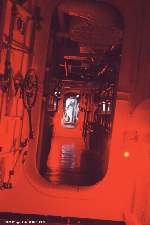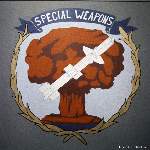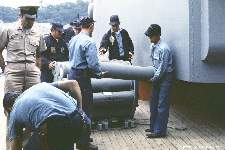by Phil Hays
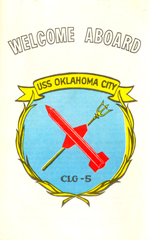
This is a story about my life on the USS Oklahoma City CLG-5 from December, 1969, through March, 1972. The Okie Boat was my home for 27 months, and I want to try to give you a feel for what it was like to live on the Flagship of the Seventh Fleet during the Vietnam War. For my shipmates who were there with me, I hope this brings back fond memories.
Someone once said that the only difference between being on a ship and being in prison was that on a ship you had a much better chance of drowning. True as it may be, prisons don't sail around the world, visiting places like Hong Kong, Tokyo, Bangkok and Singapore. Ships don't stay at sea all the time, and flagships spend a lot of time "showing the flag" in foreign ports. In that respect, it is hard for me to imagine any better duty than what we had on the Okie Boat.
The Oklahoma City was a 610 foot long, 63 foot wide box that floated 23 feet deep in the ocean. It was pointed on one end, blunt on the other, and in between were crammed boilers and engine rooms, gun and missile magazines, weapons control rooms, anchor handling equipment, air conditioning, heating and water purifications spaces, electric generators, work shops, food, fuel and water stowage, galleys and dining spaces, offices, radio rooms, toilets and berthing spaces for 1200 crewmen.
To be accurate, I should say that the ship was not made out of tin. It was made of steel up to 6 inches thick in places. But it was more or less a box, or a honeycomb of compartments, surrounded by endless expanses of water. While at sea it may as well have been a spaceship in route to Mars or an isolated cave colony deep beneath the earth. It was a self contained community, or as the Japanese called their ships, a Maru, a floating city. A description of the ship and it's crew and the ship's history can be found on other pages. If you want to know details of day to day operations check out the official U.S. Navy ships' history pages.
Like all ships, it was crowded - you don't have much private space aboard ship. We spent about two thirds of our time at sea, with all the pleasures and hardships that can bring. Shipboard life is very different from your nice comfortable home on shore. In these pages I will attempt to show a bit of what life was like on a guided missile cruiser in the third quarter of the Twentieth Century.
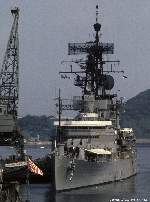
In addition to this page you will find the following pages dedicated to specific aspects of shipboard life:
Free steamingGulf of Tonkin
UNREPS (underway replenishment)
Missile operations
Shipboard life
Yokosuka
On these pages you will find hundreds of photos of the crew of the Okie Boat at work and play. Click on the thumbnails to open larger images.
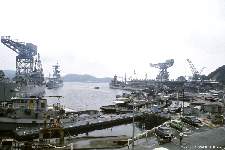
Yokosuka, Japan, was the Oklahoma City's home port while I was aboard. In fact, the ship spent much more time in Japan than in the United States (she was homported in Yoko from 1968 to 1979). The ship had been in the shipyards in Yokosuka so often that many of the ship's furnishings were Japanese. For example, some of the vent openings in the air conditioning system were marked "open" and "closed" in the Kanji characters of the Japanese language.
The picture at right shows the ship "at home" in Yoko. Tied up in front of us is USS Westchester County LST 1167, and berthed across the basin is the aircraft carrier USS Midway CV41. Fleet oiler USS Tolovana AO64 is berthed at the floating pier at the center of the basin. In the foreground are several tugs. With this many ships in port you knew it would be crowded in town that evening. There were about 5000 sailors on the carrier, and we carried 1100 more. Add in the crews of the other ships plus the men stationed on the base, and there would be 7000-8000 sailors in the bars in Honcho after liberty call.
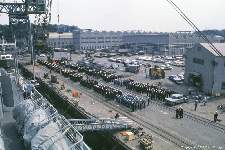
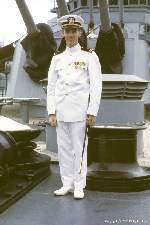
This is the ship's company lined up for inspection. We didn't do this very often, usually only when we had a change of command. Since I wasn't a division officer I wasn't required to participate, so I was free to take pictures. Here is a photo of a very young LTJG Hays decked out in dress whites for a change of command. Notice the sword - here I was, on a ship with five and six inch guns, long range surface to air and surface to surface nuclear armed missiles, and a well armed and trained Marine detachment, and I was required to carry a sword. I guess if all else failed I was supposed to repel boarders with my sword.
Every few years the ship would enter dry dock for work on the hull. There were sacrificial electrodes to be replaced, occasionally something like a propeller shaft seal had to be repaired, and the hull was cleaned and repainted.
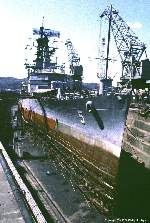

This dry dock in Yoko was constructed by the Japanese to service their largest battleships in World War Two. It was big enough to hold our largest aircraft carriers. There was room to put two ships the size of the Oklahoma City in it at the same time. Notice the pattern of indentations in the hull plating. When the ship was new in 1944 the plating was smooth. After years of pounding by waves the plating was dished in between the frames and longitudinals. The plating on the stern was 15# (15 pounds per square foot) steel - 3/8 inch thick. This increased to 35# (7/8 inch thick) on the sides. Amidships outboard the engineering spaces the ship had a 5 inch thick armor belt below the waterline.
When in dry dock all of the ship's boilers were shut down, and we were dependent upon shore services for electricity, water, and steam for heat. The ship became very cold in winter without surrounding water to insulate the hull. There was never enough steam from shore to keep it warm.
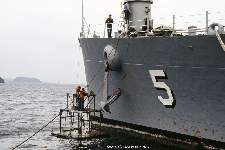
Painting is a never ending job on a ship and every part had to be touched up periodically. The anchor was about six and a half feet wide with flukes that were six feet long, and it weighed 13,000 pounds. The orange spots were "red lead," a primer. The men chipped rust spots down to bare metal and covered it with primer. The standard ocean gray paint was applied after the primer dried. You will see a lot of red lead spots in these photos. The crew worked constantly to keep the ship in top shape.
The Oklahoma City was in Yoko about four months of the year. We would come in for a few days to two weeks at a time, for work at the Ship Repair Facility and to visit families. The rest of the time we were steaming between patrols in the Gulf of Tonkin taking part in the war, or visiting just about every place in Asia where they didn't shoot at us. Great liberty in some great places is one of the perks of serving on a flagship. We spent the end of the year in Yoko, usually returning about the middle of December and getting underway early in January. We were the fleet flagship, so we could come and go as we wished - it was another of the benefits of serving on a flagship. There were other ships to do the dirty work during the holidays.

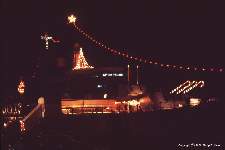
Christmas is a big deal for American servicemen and for the Japanese. Shop 'til you drop is universal. You even find Santa Claus in the department stores. The New Year celebration in Japan is even more important. As these pictures show, the ship got into the spirit of the season. The large discone antenna on the bow made a colorful tree. The six inch guns were wrapped up as candy canes, and the five inchers became candles. Nice symbols of peace on Earth and goodwill to all men, don't you think?
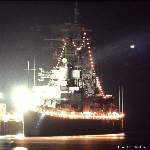
The rest of the year the ship carried liberty lights in port, as shown in this picture. You may debate whether or not it is pretty, but it had a practical value. The bright lights made it easier for sailors to find their way back to the ship. If you think this is stretching it a bit, well, I'll bet you haven't stood midwatch (midnight to 2:00 AM) on the quarterdeck and watched inebriated sailors wandering along the waterfront trying to find their way home, and then stumbling up the brow.
What does a ship look like inside? Here are some shots taken in officer's country, on the second deck forward. The ladder (stairs
to you lubbers) leads down from the quarterdeck, where the officer's brow gave access to the ship. The coat rack was for visitors to the
Wardroom, the officer's dining room, which was entered through the door to the left of the rack. Forward were staterooms, the officers'
living quarters.
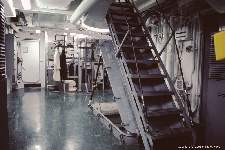
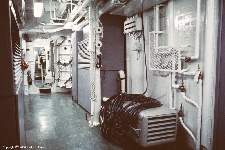
Notice all the piping and valves, and the portable electric welding unit at the side of the passageway. Classy accommodations, don't you think? This may have been a living space, but it served as a damage control station in combat.
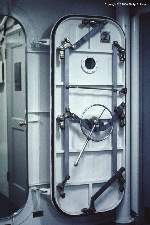
Watertight bulkheads were penetrated with water tight doors. This picture shows a "quick acting" door. Turning the handle caused all eight dogs to operate, pulling the door tightly against the seals to achieve watertight integrity. During combat these doors were always closed unless it was urgent that someone pass through. The mechanism made it possible to open and close the door in a minimum amount of time. Most doors were not quick acting, so you had to manually open and close the dogs one at a time.
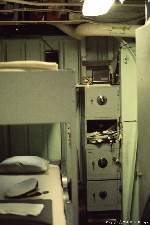
When a very junior officer first came aboard he was assigned a bunk in "boys town," stateroom 204 that wrapped around the cylindrical barbette that supported the six inch turret. We had eight bunks and just enough room to turn around. Each officer was assigned a safe to store valuables and classified materials. Unfortunately, someone lost the combination to one, and the door had been cut off. The junior Ensign (known as "George") had to wait until a more senior man moved out. We had two drawers and about one foot of closet space for each man. What didn't fit there had to be crammed wherever we could find space for it. Remember, this was officers' quarters. The enlisted men lived in bunk rooms with berths stacked three high, and even less personal stowage space.
Here are pictures of stateroom 205, where I moved when I left boys town. We had only four berths, a lot more drawers, a writing table (the front of the cabinet folded down) and a sink. We also had two arm chairs and a manhole down into one of the fuel tank spaces. These were first class accommodations.
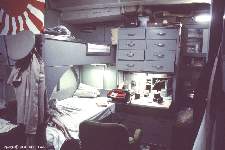
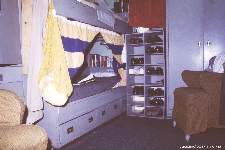
More senior officers were assigned to two man staterooms. Department heads had private rooms, as did the Captain and Executive Officer (XO - second in command of the ship). The Captain also had a smaller sea cabin located just aft of the navigation bridge where he slept when the ship was at sea. The Admiral and the fleet Chief of Staff (second in command of the fleet) had relatively luxurious quarters, similar to a very small apartment on land. No matter what the rank, creature comforts were of secondary importance to the equipment necessary for the mission of the ship.
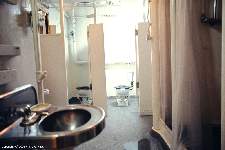
This is an officers "head," complete with toilets, shower stalls, wash basins and mirrors - all the comforts of home. Sewage was dumped over the side - actually through holes in the hull above the waterline. The plumbing was equipped with check valves to prevent water from flowing back in when the bow of the ship submerged in heavy weather. Notice the spring mounts for the toilets.
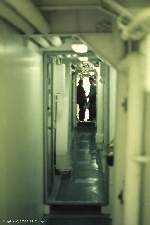
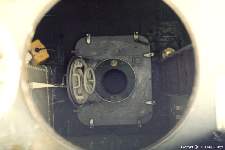
The interior of the ship was accessed by passageways running the length of the ship. In the superstructure the doors were only air tight, but below the main deck the ship was divided into water tight compartments. There were water tight doors between compartments only on the second and third decks. Below that there were no openings in the water tight bulkheads, and access to spaces was by vertical ladders. At night passageways were illuminated with red lights so our eyes would adjust to darkness. This made it safer to venture out on the open decks in the dark, as was often necessary to go to and from watch stations. Access between decks was through water tight hatches and inclined ladders, at least for primary routes. Openings into less used spaces were through round eighteen inch diameter water tight scuttles. The view down through the circular scuttle shows five deck levels, from the main deck down to the second platform.
Working spaces were just as crowded as living quarters, and sometimes even more so. This was the Special Weapons Office. I was Nuclear/Special Weapons Officer on the Okie Boat and this was my office. It also served as the GM Division Office and as a warhead handling space.
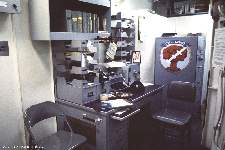
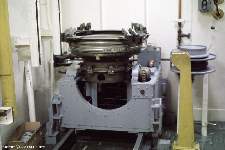
Just visible to the right of the chair is the elevator trunk down to the missile warhead magazine. There was barely room to squeeze in the desk. The big safe with the Special Weapons logo stored top secret and other classified documents related to nuclear weapons and their handling. The piece of equipment in the photo on the right was one of two warhead receiving stands, port and starboard. They traveled on rails to transfer warheads between the elevator and a hatch in the overhead that opened into the missile house maintenance area above.
I shared the desk with my yeoman and the GM Division supply petty officer. We had a typewriter, although we weren't assigned one.
It was rescued from the ocean bottom - where unserviceable equipment usually ended up. One of the men grabbed it when it was thrown out of a
ship's department office. It was ancient and had been repaired one time too many. This machine had a broken carriage spring, so when you typed
the carriage didn't advance. I replaced the spring with rubber bands and it worked OK, at least when the ship was in port. At sea we could type
only when the ship rolled to starboard.
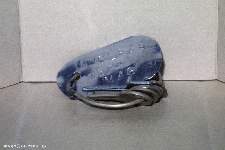
One of my duties was to be the keeper of the keys to the warhead magazine. I carried these at all times when I was aboard. Whenever I left the ship I gave the keys to the Weapons Duty Officer. A hatch in the deck in the Special Weapons Office opened to a ladder that descended two decks to another locked hatch in the deck above the warhead magazine. This was alarmed, like all accesses to nuclear weapons spaces. Before we opened the hatch an armed Marine guard was posted at the office door. Only personnel designated by the Captain were allowed into the office when the hatch was open. The Marine was authorized to shoot to kill anyone who tried to enter who was not on the Captain's list and who did not have a photo badge.
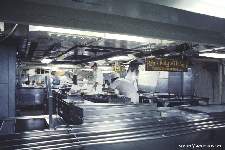
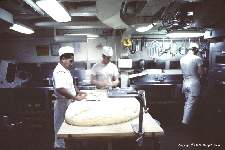
Here are pictures of the galley, the "Okie City Kitchen" where "service is our business," and the bake shop. Food was prepared in the central space and served cafeteria style to men sliding their trays on the shiny bars. On either side were tables and benches. Notice the yellow emergency lanterns on the overhead. When ships' power went out, it became very dark inside the metal box. These battery powered lanterns came on automatically when power failed so we could see.
Meals were served in two different seatings so everyone on watch would have a chance to eat. Some of the food was prepared in neighboring spaces, like the bakery. That's a lot of biscuits they were making, each rolled by hand. They had eleven hundred hungry customers.
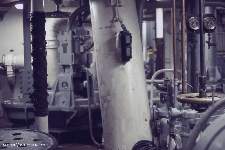
The ship also had a laundry, barber shops, a ship's store and medical and dental spaces. All were squeezed in between powder magazines,
generator rooms, document incinerators, radar rooms, and all the other equipment spaces. At left you see the anchor windlass room, a typical ship's
machinery space. In the humid atmosphere at sea, with constant motion as the ship moved through the waves, the ship was always in need of maintenance
and repairs.
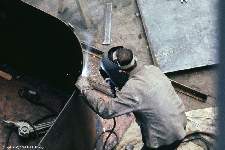
Space was always inadequate, so wherever additional room could be found more space was added. The welder was adding new bulkheads topside to enclose a part of the main deck to make a new office. It extended a space that formerly housed diving and underwater repair equipment. Our time in Yokosuka was mostly spent making repairs and modifications to the ship, and preparing to get underway on the next cruise.
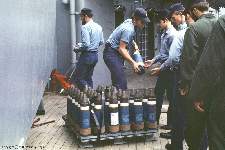

Occasionally when we were in port we would take on ammunition. Sometimes it was delivered on trucks, but usually on a barge from the Naval Weapons Depot. Pallets of projectiles and powder cases were lifted aboard by crane and placed on the main deck forward by the turret. The pallets were broken down and each bullet and powder case was carried by hand down the five deck levels to the magazines. The lower rated seamen from all ship's divisions were picked for the job. Just about anyone not on watch might be selected. Here the men are moving five inch bullets and six inch powder cans.
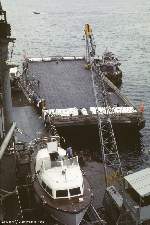
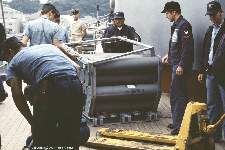
On one occasion we received missiles in port from a barge, but normally we got them during underway replenishments.


